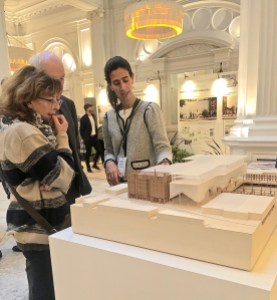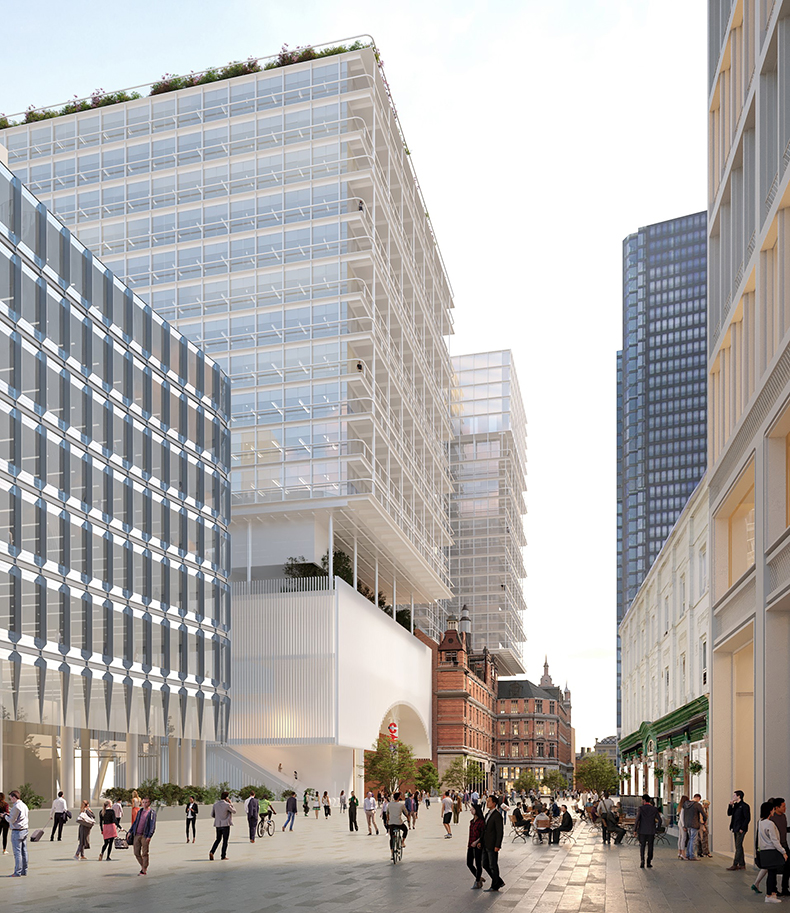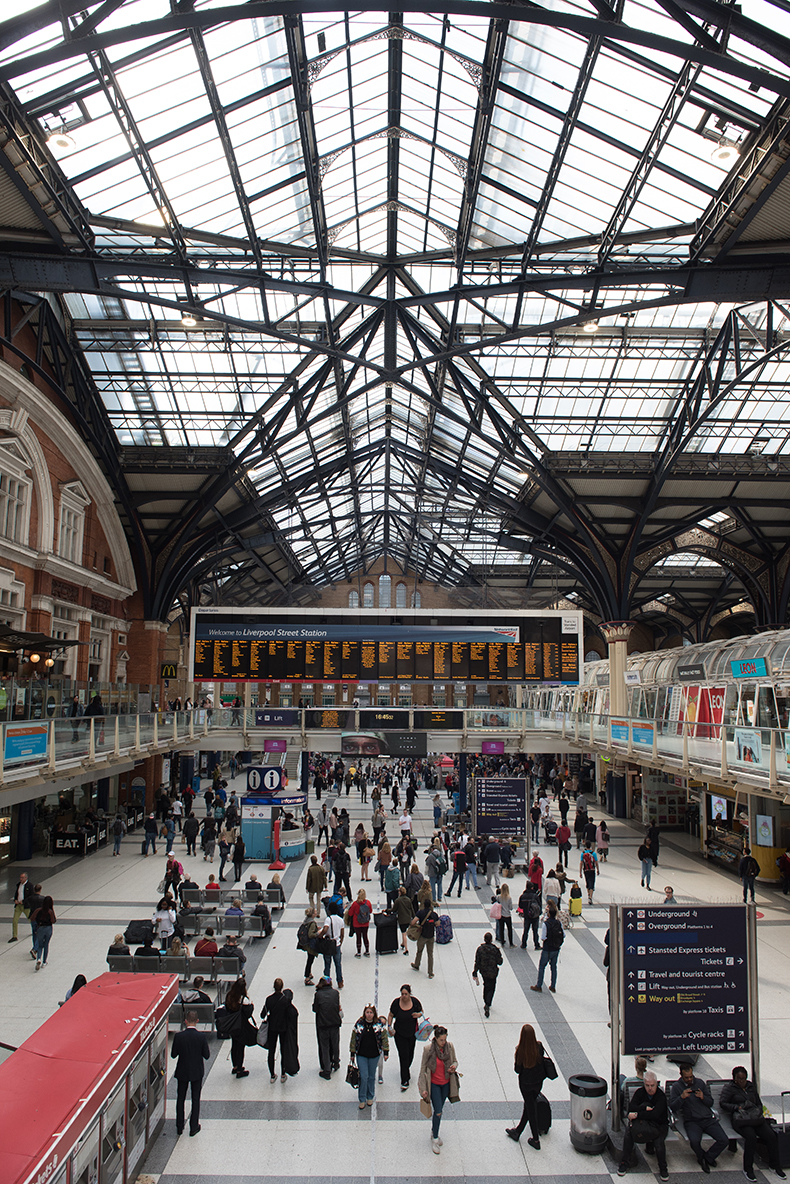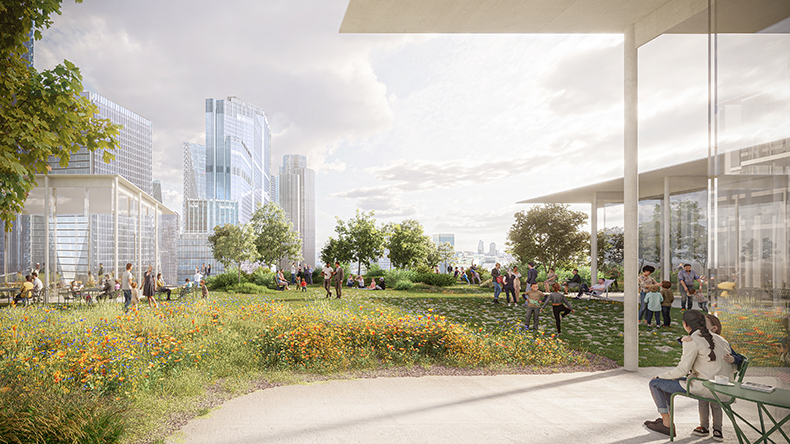‘Where is the top part?’ I asked, when shown the lower portion of a model at the public consultation for the proposed redevelopment of Liverpool Street Station by Network Rail, Sellar & MTR . ‘We don’t have it,’ replied the developers’ representative. ‘So how can I judge the impact?’ I queried, growing suspicious and feeling I was being taken for a fool.

Photo: the Gentle Author
Then I was helpfully directed to a larger, much-smaller-scale, model of the surrounding urban landscape that included a great part of the City of London and in which I had to search to find the Liverpool Street proposal amid the forest of towers. The outcome was that while I could see this would be one more tower among many, the immediate impact upon the station and the former Great Eastern Hotel (designed by Charles Barry Junior and his son and partner Charles Edward Barry, 1883–84) was less discernible.
Yet I was swiftly disenchanted of my innocence when I saw the rendering of the view down Liverpool Street with an overwhelming tower of 11 storeys squatting on top of the fine Victorian hotel like a monstrous succubus in a nightmare. My feelings of nausea were compounded on learning that this would be supported by pilings through the grade II* listed hotel which would be converted to offices and replaced by a new five-star hotel in the block on top, boasting the advantage of City views.

Courtesy Sellar/Herzog & de Meuron
London’s great railway stations – 19th-century cathedrals of glass and steel refracting the ever-changing patterns of light from our northern skies – are one of the architectural marvels of Europe. St Pancras, Paddington, Waterloo, King’s Cross and Liverpool Street are universally loved for their inspirational vaulted glass roofs. Euston, Charing Cross and Cannon Street exist as salient reminders of what has been lost through misguided redevelopment in the last century, removing the natural light by plonking ugly buildings on top.
When Liverpool Street Station (built between 1873 and 1875 for the Great Eastern Railway by chief engineer Edward Wilson) was last redeveloped between 1985 and 1992, its labyrinthine structure was clarified by the sympathetic extension of the 1870s glass roof over the platforms across the passenger concourse to meet the Great Eastern Hotel. Unfortunately, the new development proposes building over the concourse and replacing this part of the roof with a solid ceiling beneath the new office tower which itself will cast a long shadow, obscuring much of the daylight from the remaining Victorian glass vaults above the platforms.

The concourse at Liverpool Street Station in 2019. Photo: John Keeble/Getty Images
The case put forward at the consultation was that passenger access to Liverpool Street Station needs upgrading and this ‘improvement to the public realm’ can be delivered at no cost to the taxpayer by sticking a massive office block on top of the station. Yet it is a false logic, because Network Rail – as a responsible operator — has a public duty to provide adequate access. It does not follow that such overdevelopment is either necessary or obligatory in order to achieve decent public access to the station.
My heart sank when I saw the artist’s renderings of the wild-flower meadow that the developers plan to plant on top of their block and the rooftop infinity pool which is to be open to all. These are cynical sops to the public. Architects Herzog & de Meuron presumably got this job because of their conversion of Giles Gilbert Scott’s Bankside Power Station into Tate Modern. The hope was that they would bring a similar magic to Liverpool Street Station, but the brief here is entirely misconceived.

The proposed wild-flower meadow on the roof. Courtesy Sellar/Herzog & de Meuron
Why is the City of London contemplating the construction of new offices at all when so many sit empty, post-Covid and post-Brexit? Flexible working patterns mean the financial industries will require far less office space in future. I see no evidence of the City advancing any cogent or enlightened vision that accommodates to this prospect.
Thankfully, Historic England are objecting to the new development and have revised and updated their listing of the station, adding the sensitively conceived 1985/92 vaulted-glass roof over the passenger concourse which was the result of a seminal conservation battle for the station in the 1980s. The hotel has also been upgraded from grade II to grade II* (the second highest level of protection).
I understand that, for the development to go ahead in its current form, this would have to be successfully challenged and overturned, so we must now brace ourselves for a mighty and possibly protracted fight over Liverpool Street Station. The planning application is expected to be submitted at the end of April.
The Gentle Author writes daily about the culture of London at www.spitalfieldslife.com and hosts walking tours around Spitalfields.

Towering folly at Liverpool Street Station
Courtesy Sellar/Binyan
Share
‘Where is the top part?’ I asked, when shown the lower portion of a model at the public consultation for the proposed redevelopment of Liverpool Street Station by Network Rail, Sellar & MTR . ‘We don’t have it,’ replied the developers’ representative. ‘So how can I judge the impact?’ I queried, growing suspicious and feeling I was being taken for a fool.
Photo: the Gentle Author
Then I was helpfully directed to a larger, much-smaller-scale, model of the surrounding urban landscape that included a great part of the City of London and in which I had to search to find the Liverpool Street proposal amid the forest of towers. The outcome was that while I could see this would be one more tower among many, the immediate impact upon the station and the former Great Eastern Hotel (designed by Charles Barry Junior and his son and partner Charles Edward Barry, 1883–84) was less discernible.
Yet I was swiftly disenchanted of my innocence when I saw the rendering of the view down Liverpool Street with an overwhelming tower of 11 storeys squatting on top of the fine Victorian hotel like a monstrous succubus in a nightmare. My feelings of nausea were compounded on learning that this would be supported by pilings through the grade II* listed hotel which would be converted to offices and replaced by a new five-star hotel in the block on top, boasting the advantage of City views.
Courtesy Sellar/Herzog & de Meuron
London’s great railway stations – 19th-century cathedrals of glass and steel refracting the ever-changing patterns of light from our northern skies – are one of the architectural marvels of Europe. St Pancras, Paddington, Waterloo, King’s Cross and Liverpool Street are universally loved for their inspirational vaulted glass roofs. Euston, Charing Cross and Cannon Street exist as salient reminders of what has been lost through misguided redevelopment in the last century, removing the natural light by plonking ugly buildings on top.
When Liverpool Street Station (built between 1873 and 1875 for the Great Eastern Railway by chief engineer Edward Wilson) was last redeveloped between 1985 and 1992, its labyrinthine structure was clarified by the sympathetic extension of the 1870s glass roof over the platforms across the passenger concourse to meet the Great Eastern Hotel. Unfortunately, the new development proposes building over the concourse and replacing this part of the roof with a solid ceiling beneath the new office tower which itself will cast a long shadow, obscuring much of the daylight from the remaining Victorian glass vaults above the platforms.
The concourse at Liverpool Street Station in 2019. Photo: John Keeble/Getty Images
The case put forward at the consultation was that passenger access to Liverpool Street Station needs upgrading and this ‘improvement to the public realm’ can be delivered at no cost to the taxpayer by sticking a massive office block on top of the station. Yet it is a false logic, because Network Rail – as a responsible operator — has a public duty to provide adequate access. It does not follow that such overdevelopment is either necessary or obligatory in order to achieve decent public access to the station.
My heart sank when I saw the artist’s renderings of the wild-flower meadow that the developers plan to plant on top of their block and the rooftop infinity pool which is to be open to all. These are cynical sops to the public. Architects Herzog & de Meuron presumably got this job because of their conversion of Giles Gilbert Scott’s Bankside Power Station into Tate Modern. The hope was that they would bring a similar magic to Liverpool Street Station, but the brief here is entirely misconceived.
The proposed wild-flower meadow on the roof. Courtesy Sellar/Herzog & de Meuron
Why is the City of London contemplating the construction of new offices at all when so many sit empty, post-Covid and post-Brexit? Flexible working patterns mean the financial industries will require far less office space in future. I see no evidence of the City advancing any cogent or enlightened vision that accommodates to this prospect.
Thankfully, Historic England are objecting to the new development and have revised and updated their listing of the station, adding the sensitively conceived 1985/92 vaulted-glass roof over the passenger concourse which was the result of a seminal conservation battle for the station in the 1980s. The hotel has also been upgraded from grade II to grade II* (the second highest level of protection).
I understand that, for the development to go ahead in its current form, this would have to be successfully challenged and overturned, so we must now brace ourselves for a mighty and possibly protracted fight over Liverpool Street Station. The planning application is expected to be submitted at the end of April.
The Gentle Author writes daily about the culture of London at www.spitalfieldslife.com and hosts walking tours around Spitalfields.
Unlimited access from just $16 every 3 months
Subscribe to get unlimited and exclusive access to the top art stories, interviews and exhibition reviews.
Share
Recommended for you
The battle to save London’s mulberry trees
Mulberry trees are rare in the city, yet more than one is currently under threat – including the oldest tree in the East End
The contradictory career of Decimus Burton
The architect was once best known for his neoclassical buildings, but his reputation now rests on the glasshouses at Kew Gardens
Tracey Emin airs her feelings at St Pancras station
Boundaries between the personal and the political are broken down in Emin’s new public artwork